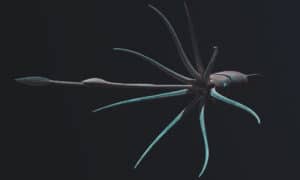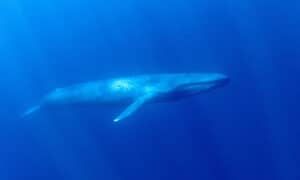
In Nordic folklore, seafaring pirates feared the unknown monsters of the ocean, especially the Kraken. This enormous squid-like creature was said to have engulfed entire ships in treacherous waters bringing the crews down with it. Although the infamous Kraken only exists in maritime storytelling, it is speculated that it was inspired by some very large, very real deep-sea squid.
There are around 300 recognized species of squid although it is believed there are more yet to be discovered. These animals are incredibly diverse and are unique in a number of ways. Squid come in a vast array of different colors and many, like the bioluminescent firefly squid and vampire squid, are capable of glowing in the dark.
With more than 300 species of squid, their diet can vary dramatically. Squid are omnivorous and the larger species will eat anything they can catch, including sharks and smaller squid. Crustaceans such as shrimp and some species of fish are primary sources of nutrition for squid.
These animals also come in many different sizes ranging from the tiny 0.175-gram pygmy squid to the largest invertebrate on the planet. This article will dive deeper into what is known about these mysterious animals. Here are the five largest squid in the world based on maximum weight.
#5: Humboldt Squid – 110lbs
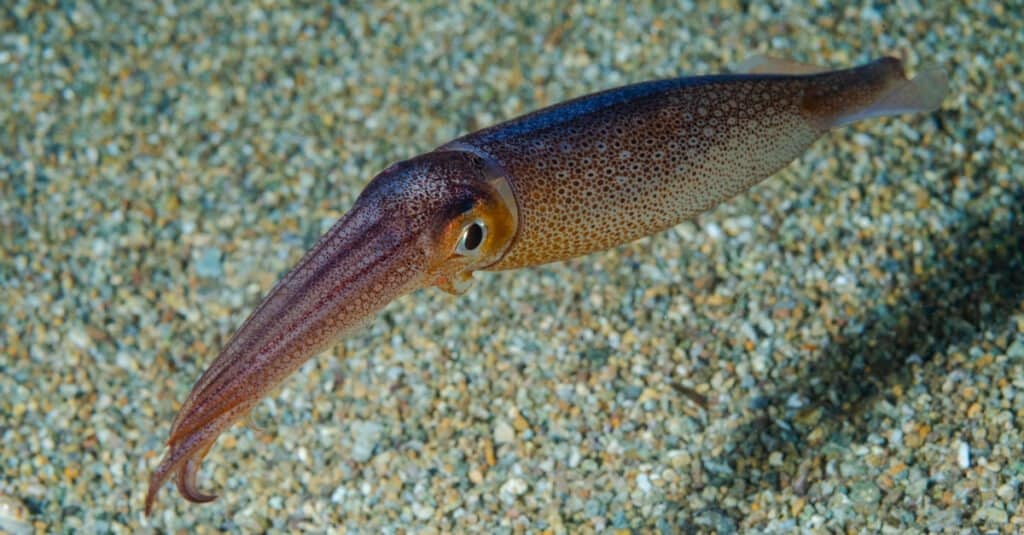
Flying squid have been known to “fly” during migration and to escape predators.
©Shpatak/Shutterstock.com
The Humboldt squid, often called the jumbo squid, can grow up to 110 pounds with a maximum length of up to 7 feet. This squid lives in the eastern Pacific Ocean and is the largest of the flying squid. They are most often found in large shoals of about 1,200 individuals and live at depths between 660 and 12,300 feet. The conservation status of this animal is classified as data deficient.
Humboldt squid can swim up to 15 miles per hour and are vicious predators. They primarily feed on other mollusks, small fish, and crustaceans, but are also frequent cannibals. In pursuit of prey, Humboldt squid chase down and attack using their barbed tentacle suckers. They then tear apart the prey’s flesh with their razor-sharp, parrot-like beak. Each sucker has a ring of sharp teeth and the squid’s beak can easily tear tough tissue. There have been verified reports of human attacks, primarily on deep-sea divers.
The Humboldt squid also has fascinating chromogenic behavior. This means they are able to generate light and use it as a tool to produce communicative signals. They produce red and white light across their entire body that they flicker between at different rates and intensities. It is possible that this is primarily a tool for communicating within the species either for mating purposes or as a warning signal.
#4: Robust Clubhook Squid – 110lbs
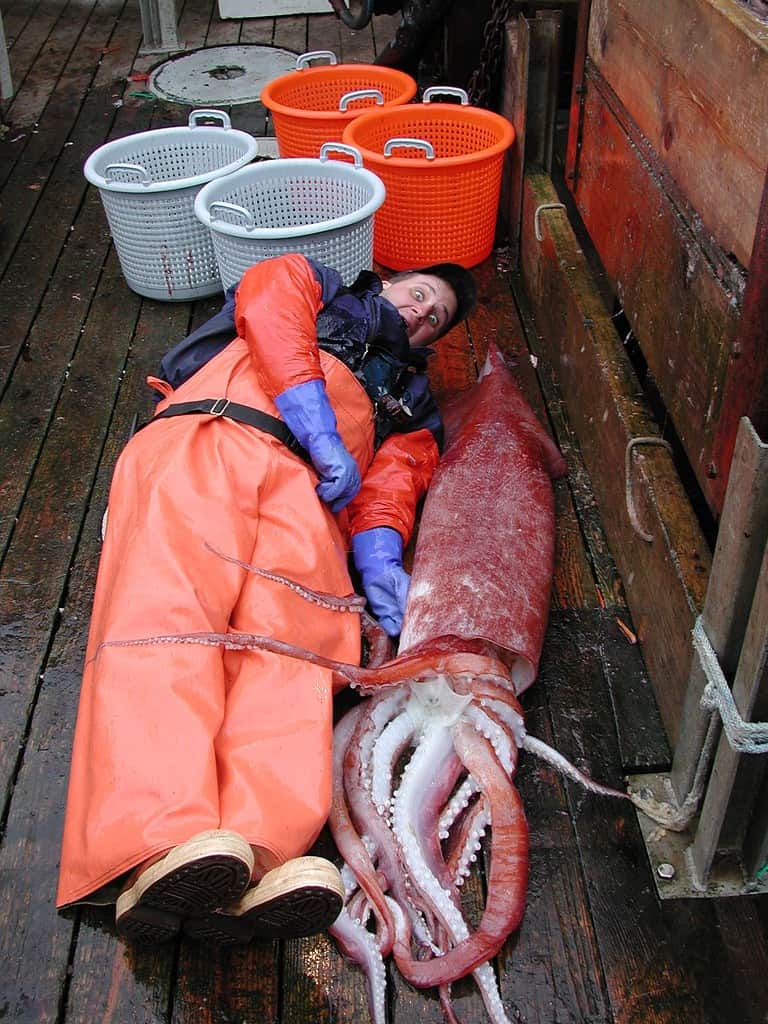
NOAA worker lying next to Robust Clubhooked Squid to show comparative size.
©U.S. National Oceanic and Atmospheric Administration/Public Domain – License
The robust clubhook squid can grow up to a whopping 110 pounds with an exceptional length of up to 13 feet. This rare squid lives in the northern Pacific Ocean at depths of 100-1,700 feet and is the largest in its family of hooked squids. The robust clubhook squid reportedly feeds on small fish and jellyfish, such as the brown jellyfish that is native to the northern Pacific. This squid is prey to sperm whales, sharks, and fur seals. The conservation status of the robust clubhook squid is classified as data deficient. It earns its name from its distinctive tentacular clubs. Each tentacle contains 15 to 18 club hooks that can latch onto prey. Each arm of the robust clubhook squid has 50-60 suckers and can grow to be as long as the mantle (the “body”) of the squid.
#3: Dana Octopus Squid – 356lbs
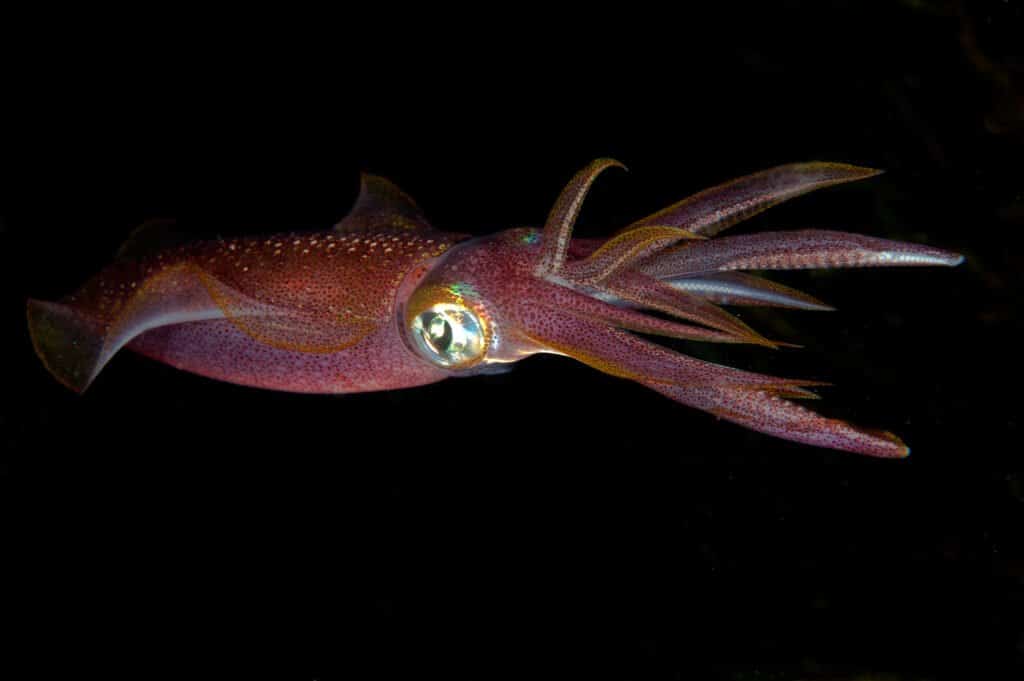
Red squid live deep in the ocean.
©Konstantin Novikov/Shutterstock.com
The largest recorded Dana octopus squid weighed a massive 356 pounds and was 7.5 feet long. They live in every ocean except the polar seas in depths up to 2,400 feet below sea level. This squid’s conservation status is classified as being of least concern.
The Dana octopus squid is prey to lancetfish, swordfish, hammerhead, tiger and blue sharks, short-finned pilot whales, and most prominently, sperm whales. Scientists believe these squid are skillful, highly maneuverable swimmers that can be quite evasive. There are few observations of this species in the wild and fewer specimen collections. Nevertheless, some animals have been documented using evidence from the stomachs of sharks.
The Dana octopus squid uses bioluminescence as a tool for communication and hunting. Footage of a dana octopus squid using a unique hunting strategy in its natural habitat became available for the first time in 2005. The squid emits blinding flashes of light to stun and disorient its prey when it attacks. It then uses its tentacles and sharp beak to trap and consume its prey. Interestingly, juvenile squid flash a light and charge at potential predators as a defensive intimidation tactic to stun and confuse them. It has also been suggested that bioluminescence is used for mating or territorial purposes.
#2: Giant Squid – 606lbs

Giant squids
can reach incredible lengths.
©sciencepics/Shutterstock.com
The Atlantic giant squid is estimated to weigh up to 606 pounds and is capable of reaching lengths between 39-43 feet, making it the longest in the world. Giant squid inhabit the deep sea between an estimated 989-3,280 feet and have therefore been incredibly hard to study. Very few have been studied alive and most of what is known about them comes from studying carcasses that have washed up onto beaches. Carcasses have been found around the world suggesting they inhabit many of the world’s oceans, however, specimens are rarely found in tropical or polar latitudes. The first pictures of a live giant squid were not taken until 2004 by a team of Japanese scientists.
These creature’s diets consist of deep-sea fish species, other smaller squid, and possibly some whales. The giant squid is a solitary hunter and catches its prey using two tentacles with barbed suckers. There is some evidence that giant squid may be cannibalistic- parts of a giant squid beak were found in the stomach contents of another giant squid in Tasmania. Sperm whales are the only predators of giant squid and scientists often try to track the whales in an attempt to locate giant squid.
Giant squid have one of the largest eyeballs on earth measuring up to 11 inches in diameter. Having such large eyes allows them to detect light in the darkest parts of the deep sea. Scientists are also greatly interested in the giant squid’s complex brain and nervous system.
#1: Colossal Squid – 1,090lbs
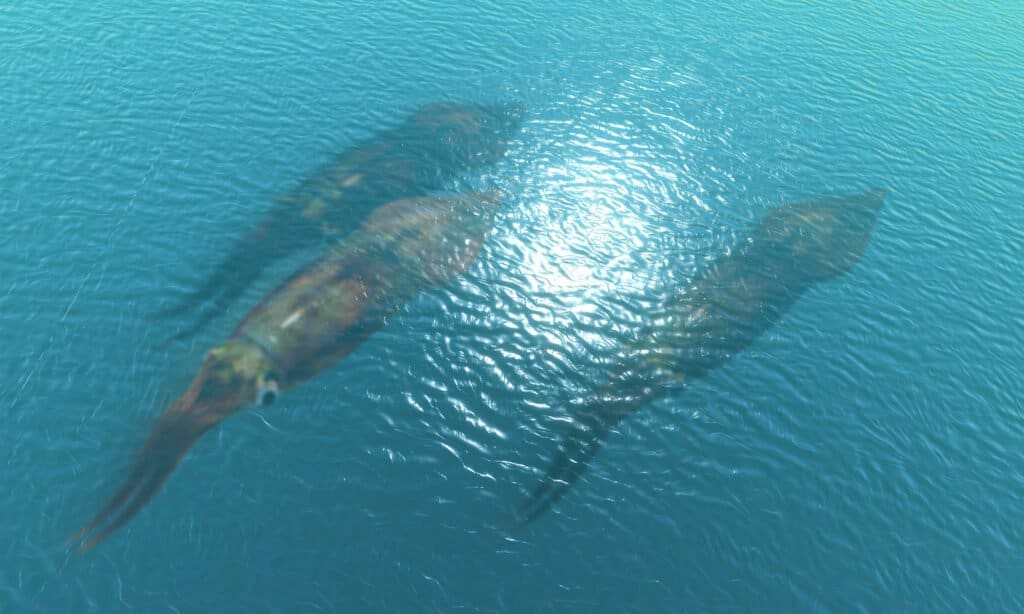
Colossal squid aren’t as long as giant
squids but have heavier bodies.
©Jiri Flogel/Shutterstock.com
The colossal squid is incredibly large with a weight of at least 1,090 pounds and a length estimated between 30-33 feet. This size makes the colossal squid the largest in the world.
The largest confirmed colossal squid weight is 1,090 pounds based off of a live specimen captured in 2007; however, based on their beaks that have been recovered, scientists predict they can reach weights up to 1,300-1,500 pounds. Colossal squids are shorter than giant squids but are heavier and have larger eyes measuring 12-16 inches in diameter.
Colossal squid are ambush predators and use bioluminescence to attract their prey. They are also a significant prey of sperm whales. Many sperm whales have been studied with scarring and injuries inflicted by colossal squid. Beaks have also been collected from sperm whale stomachs.
These squid primarily inhabit the Southern Ocean circumferential to Antarctica up to 13,000 feet deep. Because they live at such extraordinary depths, there is much more to learn about these creatures.
Summary Of The World’s 5 Largest Squid
There are hundreds of types of squid, and we expect to discover many more. Many of them communicate using bioluminescence. These animals range in size from tiny to massive. These are the five largest species:
| Rank | Species | Weight |
|---|---|---|
| 1 | Colossal Squid | 1090lbs. |
| 2 | Giant Squid | 606lbs. |
| 3 | Dana Octopus Squid | 356lbs. |
| 4 | Robust Clubhook Squid | 110lbs. |
| 5 | Humboldt Squid | 110lbs |
The photo featured at the top of this post is © Ernie Hounshell/Shutterstock.com
Thank you for reading! Have some feedback for us? Contact the AZ Animals editorial team.




